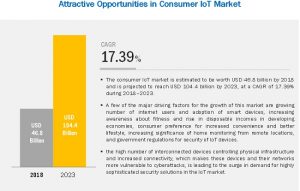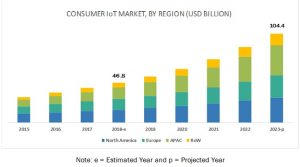How consumer IoT demand in electronics, smart home and healthcare is growing with new tech to 2023

Sachin Garg of MarketsandMarkets
The Consumer Internet of Things is the network of consumer devices used in various end-applications, such as smart homes, healthcare, and consumer electronics. The consumer IoT market is estimated to be valued US$46.8 billion (€41.3 billion) by 2018 and is projected to reach US$104.4 billion (€92.1 billion) by 2023, at a CAGR of 17.39% during 2018–2023.
The growth of the consumer IoT market can be attributed to the growing number of internet users and adoption of smart devices, increasing awareness about fitness and rise in disposable incomes in developing economies, consumer preference for increased convenience and better lifestyle, increasing significance of home monitoring from remote locations, and government regulations for security of IoT devices, says Sachin Garg, associate vice president, Emerging Technologies of MarketsandMarkets.

The consumer IoT market is witnessing many technological advancements. The companies’ emphasis on launching comprehensive IoT solutions for their customers is likely to drive the consumer IoT market. For example, in February 2018, Qualcomm Technologies announced IoT development kits based on the QCA4020 and QCA4024 SoCs.
The kits are designed for IoT applications such as smart cities, toys, home control and automation, appliances, networking, and home entertainment. The kits provide interoperability among diverse IoT devices including popular wireless standards, protocols and communication frameworks, and easy connectivity to various cloud and application services.
The consumer IoT market for solutions is expected to grow at the fastest CAGR during the forecast period. The solution segment consists of software and platform. With the increase in the number of connected devices, the volume of data is also proliferating. Such huge data volumes are driving the market for data management software.
By implementing the IoT data management software, businesses are aiming to get a competitive edge with predictive analytics, as well as optimise their business operations. Moreover, the high number of interconnected devices controlling physical infrastructure and increased connectivity, which makes these devices and their networks more vulnerable to cyberattacks, is leading to the surge in demand for highly sophisticated security solutions in the IoT market.
The market for home automation is expected to grow at the highest CAGR from 2018 to 2024. The increasing demand of home monitoring in remote locations as well as the growing adoption of home automation devices in applications such as security, and HVAC and energy management, among others, have been the key factors driving the growth of the consumer IoT market for home automation. Further, the rising demand among customers for better and convenient lifestyle and increased internet penetration in smart devices also contribute to market growth.
APAC is expected to register the highest CAGR in the global consumer IoT market from 2018 to 2024. The increasing reach of internet across residential spaces, high consumer base, rapid urbanisation, increasing disposable income, and improving IT infrastructure are a few of the key determinants supplementing the growth of the consumer IoT market in APAC. China, India, and Japan are making heavy investments in R&D to encourage the adoption of IoT; this would boost the demand for IoT hardware and software solutions in the future.
China, as part of its 13th 5-year plan for economic and social development (2016–2020), has been promoting the development of infrastructure, service platforms, and major applications of IoT. Additionally, many international industry giants aim to expand their footprints in India; for instance, in October 2017, Vodafone (UK) announced its plan of launching NB-IoT in the country. The company focusses on the consumer IoT space in the country as part of the growth strategy for its IoT business.

The author is Sachin Garg, associate vice president, Emerging Technologies of MarketsandMarkets
Comment on this article below or via Twitter @IoTGN
